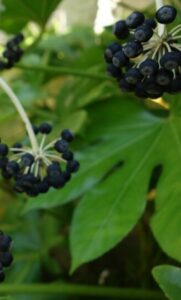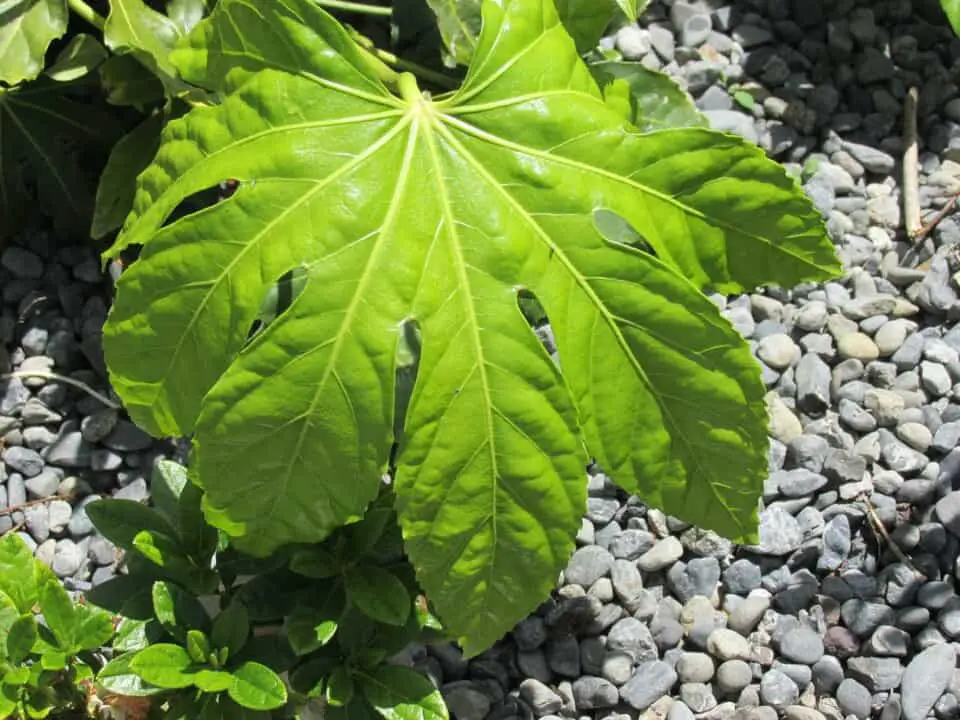Some links in the post are affiliate links and I get a commission from purchases made through some links found in the post.
The fatsia japonica grows five feet (1.5 meters) tall on average and spreads about 4 feet (1.2 meters). As I type this, I can feel the urge to add yet another of these beauties to my space.
You might read this and wonder just how much space I have in my home. The truth is that it’s not much. Most of what remains now has partial access to the sun.
But that’s the other great thing about the fatsia japonica – it does well in partial shade. It can even grow in heavy shade without losing its glossy leaves.
So, if you’ve been looking for a plant to stash down that hallway or light up that north-facing room, I may have found one for you!
As suggested this means that you can grow your fatsia japonica in a pot and keep it both indoors or outdoors depending on where you are located in the world.
This guide shows you how you can plant your fatsia japonica in a pot and even takes you through some of the best options in the market. How great is that!
Can I Grow Fatsia Japonica in A Pot?
 You can grow a fatsia japonica in a pot but having it in a pot will most likely mean that it won’t reach it’s optimum natural height of 4.8 meters.
You can grow a fatsia japonica in a pot but having it in a pot will most likely mean that it won’t reach it’s optimum natural height of 4.8 meters.
You will need to make sure you regularly water it and it is fed well during it’s active growing months.
Outdoors, the fatsia japonica can be as tall as 16 feet (4.8 meters)! And for most houses, housing such a tall plant is not possible. But the good thing is that you can still grow your fatsia japonica indoors. How?
When you pot a plant and move it indoors, you deprive it of its natural growing habitat. As such, you limit how much it can grow because you restrict the actions of its roots.
That’s why most indoor fatsia japonicas never go past five feet in height. If five feet feel like too much for you, pruning the fatsia japonica is always a welcome idea.
I know someone who always cuts her plant in the summer because it keeps growing so fast. So, if you want to keep a smaller plant or shape your fatsia japonica, you might want to consider this strategy.
If you are okay with your plant growing up to 5 feet tall, all you need is to provide it with the right growing conditions. These include:
1) Watering
Your fatsia japonica needs regular watering to ensure its soil does not dry out completely. You will need to reduce the regularity of the watering once the cold months start.
Temperature
Maintain temperatures between 50- and 80-degrees Fahrenheit. This plant grows in hardiness zones 7 to 9 and can withstand colder temperatures.
Humidity
The humidity in your home should be sufficient. Even so, keep the plant away from cold and hot air drafts.
Feeding
Use a weak liquid fertilizer on your fatsia japonica twice a month during its active growing season. In the winter and late fall, please do not feed the plant.
Please note that these requirements still apply even if you want to maintain a small plant. An unhealthy fatsia japonica does not boast glossy dark green leaves.
Instead, it takes on brown and yellowing foliage with leggy stems. Ensure your plant gets the care it needs, and it will reward you with healthy growth.
You may also like: What soil does a fatsia japonica like
Where Should I Place the Fatsia Japonica Pot?
When locating your fatsia japonica, you must think of the best light for the plant. This plant does not like direct light.
Instead, it prefers indirect light, which can be bright, medium, or low. When choosing a spot for your plant, consider these options:
For variegated fatsia japonicas
These plants do well in bright indirect light. Being in low lighting robs them of their variegation. So, place them near an east, west, or south-facing window and protect them from the direct sun using sheers.
For other fatsia japonicas
You can leave these plants in low or medium indirect light. You can get this light in the middle of east or west-facing rooms or other rooms in the house that don’t have as much access to light.
If your plant starts exhibiting leggy or leaning growth, stunted growth, and poor leaf development, move it closer to light. But if its leaves start drooping, yellowing, or browning, move it away from light.
When Should I Repot Fatsia Japonica?
 The fatsia japonica grows at a rate of 8 inches on average each year, spreading its dark leaves further into your space. And if you feed it, this rate can go up to 10 or 12 inches annually.
The fatsia japonica grows at a rate of 8 inches on average each year, spreading its dark leaves further into your space. And if you feed it, this rate can go up to 10 or 12 inches annually.
Many people tend to forget that as a plant grows upwards and outwards, it also grows downwards.
Your fatsia japonica’s roots will get to a point where they can no longer spread further. And when this happens, you will notice signs such as:
- The plant stops growing as fast as it should even if it has access to its basic care needs,
- Roots sticking out of the pot’s drainage holes or the soil surface, and
- Water collecting on the soil surface when you water the plant.
These signs show that your plant is now rootbound and needs another home (pot). Typically, these signs come about annually.
But to be sure, you can inspect the plant’s roots by wiggling the plant out of the pot. Do the roots appear curled around each other?
Take that as a sign that the plant needs more space for its roots to spread. You may also need to repot the plant if it has suffered root damage due to root rot. In either case, I have outlined the steps that you should follow below.
You may also like: 10 most common fatsia japonica problems & how to fix them
How To Repot the Fatsia Japonica
Does your plant show signs of being rootbound? Has it suffered root damage? Here’s how you can repot it in a few simple steps:
1) Ensure the plant is actively growing: Repotting a dormant plant is not a good idea as it reduces the plant’s ability to recover.
So, it’s best to repot your plant in the summer or the spring. If you must do it in the fall, you should do it early in the season.
2) Find a pot that is a size or two bigger than the current pot. The replacement pot must have enough drainage holes.
3) Fill the replacement pot to half its height with well-draining and well-aerated soil with a slightly acidic or neutral pH.
The fatsia japonica is not very selective when it comes to nutrition. But getting a nutrient-dense potting mix can save you a lot of work moving forward.
4) Wet the potting mix to loosen the bond between the fatsia japonica and the soil. Give it about 20 minutes, then lay the pot on its side. Slowly wiggle the plant out of the pot, ensuring you do not disturb its roots.
5) If you are repotting the plant because its roots have suffered damage, you need to assess how bad the damage is.
Then cut off the affected parts with a sharp and sterile knife and treat the plant with a fungicide.
Please leave it to dry for a few minutes. If the plant does not have any root damage, you can immediately move on to the next step.
6) Place the fatsia japonica in the potting mix and cover it with more potting soil, leaving two to three inches at the top.
Then water it and allow the excess water to drain from the drainage holes. You can now set the plant in a spot with low, medium, or bright indirect light.
Your plant may appear droopy in the days that follow as it gets used to its new home. However, you should not let that worry you. Instead, keep giving the plant its basic care needs, and it will perk up soon enough.
You may also like: Fatsia japonica light requirements
Our 5 Recommended Pots for A Fatsia Japonica
What should you consider when choosing a pot for a fatsia japonica?
- Drainage: The pot must have sufficient drainage holes to allow the excess water to drain,
- Size: Is the pot big enough to hold your fatsia japonica?
- Design: How well does the pot fit into your décor?
Below are some of the options you can consider:
1) HB Self-Watering and Self-Aerating Pots
These 8-inch pots feature a two-week self-watering design that allows you to go about your business and leave the watering to them.
More importantly, they do not flood your plant.
2) HOMENOTE Plastic Planters
These plastic pots come in various sizes, enabling you to choose what is suitable for your fatsia japonica.
Moreover, they feature a tray which collects the excess water rather than letting it drain onto your floor.
3) The La Jolie Muse Planter
Breathability is vital in maintaining a healthy root system, and this 11.3-inch planter hits this nail on the head. It features a lightweight build that features stone powder.
Plus, it has preinstalled drainage holes to ensure that no water sits around the fatsia japonica’s roots.
4) Santino ASTI 9.2 Inch Self Watering Planter
Here is another self-watering planter that is easy on the eyes. It comes in an array of colors and sizes and is an excellent alternative to ceramic pots.
Its lightweight design is another plus atop its drainage capabilities.
5) DecoPots Self Watering Planter
With 3 pots, you can plant as many as 3 fatsia japonicas or include other houseplants in your space.
It also features a self-watering technique that enables you to save time on watering your plant. Plus, it ensures optimal air circulation.
When propagating your fatsia japonica the first time, go for smaller sizes so you can work your way to bigger pots over time.
Final Thoughts
Did you know that you can root new fatsia japonicas from your mature plant? All you need is to take a fresh stem cutting during the active growing season.
Then treat it with a rooting hormone and place it in well-draining and moist soil for about a month. You should see new growth soon enough, enabling you to have yet another beautiful plant in your home.
Happy Gardening!






